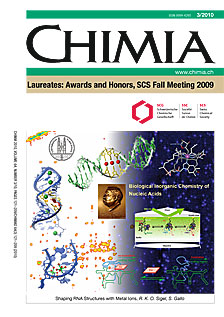Shaping RNA Structures with Metal Ions and Metal Ion Complexes
DOI:
https://doi.org/10.2533/chimia.2010.126Keywords:
Coenzyme b12, Metal ions, Ribozymes, Riboswitches, Rna/dnaAbstract
The research in our laboratory focuses on the role of metal ions and their complexes in structure formation and folding of nucleic acids. Large catalytic RNAs, like group II introns and some riboswitches, as well as shorter RNAs and DNAs containing modified nucleotides for the assembly of nanodevices are examined. Abundant metal ions like Mg2+ or natural metabolites like coenzyme B12 are in the center of interest, but also other metal ions, complexes thereof and B12 derivatives are applied with the aim to understand the largely unknown and manifold non-covalent interactions with nucleic acids. We apply a multitude of techniques, including potentiometric pH titrations, NMR spectroscopy, X-ray crystallography, gel electrophoresis and single molecule FRET experiments. Here we briefly summarize each of our research topics emphasizing the interaction of coenzyme B12 and its derivatives with the btuB riboswitch of E. coli. This highly conserved sequence, found in the 5'-untranslated region (5'-UTR) of the btuB mRNA, is involved in the regulation of the btuB protein expression. After a summary on the historical discovery of such riboswitches and their mechanism of action, we shortly focus on our own contributions to understand the structural equilibrium, high affinity and selectivity of the interaction between this specific RNA sequence and the largest and most complex cellular metabolite, coenzyme B12.Downloads
Published
2010-03-31
Issue
Section
Scientific Articles
License
Copyright (c) 2010 Swiss Chemical Society

This work is licensed under a Creative Commons Attribution-NonCommercial 4.0 International License.
How to Cite
[1]
R. K. O. Sigel, S. Gallo, Chimia 2010, 64, 126, DOI: 10.2533/chimia.2010.126.







